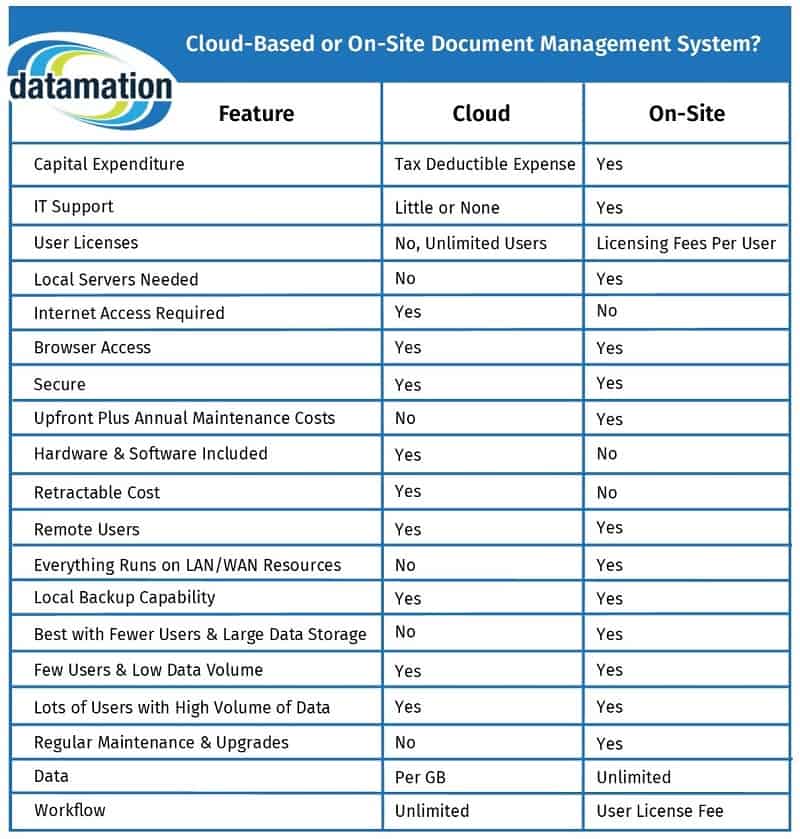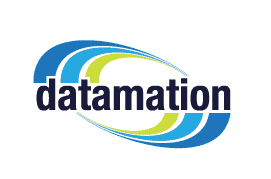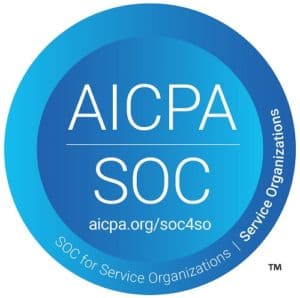Are you still doing the majority of your organizational tasks on paper? Do you loathe a request because you know that you’re going to need to walk down to the storage room and rummage around paper files for an hour? Then it sounds like it’s time for a document management solution.
Every day business moves faster, more goes digital, and it’s costly to stick to old systems and habits just because it’s what you’ve been doing. Scanning your files and media provides a ton of benefits and you don’t necessarily have to change everything overnight.
Let’s go through the three levels of document management, what they each mean, and how you can implement them for your own business.
If you want to jump to a specific section:
- Basic Scanning and Archiving
- Document Management System for Storage and Retrieval
- Fully Integrated Document Management Solution
1. Basic Scanning and Archiving
 The first level is basic archiving. This means scanning your records how they are in their file folders and naming your new digital files after the folder. Once documents are scanned, you can store digital files on your network server or an external hard drive. Not only will this clean up your paper files, but it creates a reliable back up in case of a disaster.
The first level is basic archiving. This means scanning your records how they are in their file folders and naming your new digital files after the folder. Once documents are scanned, you can store digital files on your network server or an external hard drive. Not only will this clean up your paper files, but it creates a reliable back up in case of a disaster.
You have two options when you want to scan your files: do it yourself or outsource it to a document scanning company.
DIY, Internal Scanning
If you want to scan your own files, you’ll need to purchase or rent a document scanner. Personally, we recommend desktop scanners from Kodak or Epson. These scanners are easy to use and can usually be purchased for under $350. If you know you’re not going to need or want a scanner after conversion, these and other production scanners can also be rented.
Outsourced Scanning
If you choose to outsource your scanning, the company will come to your office, box up your records, take them back to their office, and scan them at your specifications. Make sure that you decide prior to conversion exactly how you want your files to be named and what format you want them in (e.g. PDF, TIFF, etc.). If unsure, ask the company!
Outsourcing will also allow your files to be made text searchable so you can find anything you need within the body of the document.
The cost to outsource is around $.05 to $.08 per image scanned. This makes a standard banker’s box of files cost around $200 for a full scan with text searchability.
Related resource: Should You Outsource Document Scanning or Do It In-House?
2. Document Management System for Storage and Retrieval
The next level, and what most companies are migrating towards these days, is a document management system for storage and retrieval. You may have also heard these referred to as content management systems or imaging systems. The focus of this system is to have a centralized repository of all of your content – and not just your previously scanned files. These can include emails, PDFs, spread sheets, video, audio, and CAD files, among others.
Are Document Management and Enterprise Content Management the Same Thing?
 Sometimes document management system is used interchangeably with enterprise content management, but they aren’t entirely the same thing.
Sometimes document management system is used interchangeably with enterprise content management, but they aren’t entirely the same thing.
Document management system (DMS) refers specifically to how you store and access your documents, along with monitoring the lifecycle of those documents.
Enterprise content management (ECM) is how every single piece of information in your business is used. This includes strategies and tools like workflow that are programed to send your information to the person who needs it. We’ll touch on ECM more in level three.
Now that you know the basic differences, let’s go more in-depth with document management software.
Benefits of a Document Management System
The power of a document management system lies in its capability and scalability to become an enterprise solution. Benefits of a document management system include:
- improving business processes
- protecting information from theft and disaster
- helping comply with regulations and guidelines
- collaborating among teams, whether in-person or remote
Types of Document Management Systems
 There are two methods for implementing a document management system: on-premises software or an outsourced cloud.
There are two methods for implementing a document management system: on-premises software or an outsourced cloud.
For an internal, on-site system, you’ll need to purchase software. These sell for around $1,800 to $2,500 per license, though does not include any kind of installation or training services. All of this is hosted on your own servers and will need continual IT resources.
Outsourced cloud solutions start around $120 per month. For some software, you can have unlimited users. Others, they may charge per user but provide far more features. There is no term minimum or maximum – you use the system as long as you want. And since the software is hosted and maintained elsewhere, you do not need to have nearly as many dedicated IT resources, if any.
Which Document Management System is Best for My Business?
Either solution is a good solution, but it’s really up to your organization and culture to decide what will work best for you. Here’s a side-by-side comparison chart to help.
Please note that this chart compares PaperVision Enterprise software to ImageSilo. Other software comparisons may differ.

For a downloadable PDF of this chart, click here.
More and more small and mid-sized businesses are choosing cloud-based systems so they don’t have to invest heavily in IT support. Larger organizations tend to favor on-premises systems so that they have full control over every facet of their information.
That being said, it’s still best to analyze your current and future business goals when making this decision!
3. Fully Integrated Document Management Solution
 The last level is implementing advanced system features to have a fully integrated document management solution. This is basically your enterprise content management, or possibly content services, as you will need to consider multiple processes and tools in addition to your document storage.
The last level is implementing advanced system features to have a fully integrated document management solution. This is basically your enterprise content management, or possibly content services, as you will need to consider multiple processes and tools in addition to your document storage.
At this level, you can use advanced features to really revolutionize the way that you work. You can change your business processes to be more efficient than ever. In fact, many companies choose their document management systems based on what advanced features they can have.
Depending on the system you have, these will either be included in your price or need to be purchased as add-on licenses.
The advanced system features fall into three main buckets:
- workflow
- integration
- e-forms
Workflow
 The most commonly implemented advanced feature is workflow. Workflow provides automated routing, checklists, approvals, integrations, and reporting.
The most commonly implemented advanced feature is workflow. Workflow provides automated routing, checklists, approvals, integrations, and reporting.
Examples include:
- Tracking and assigning insurance claims based on workload and processor specialty
- Routing an invoice to a department head for approval and general ledger (GL) coding
- Matching and approving an invoice based on the purchase order (PO) and receiving information
- Administering and calculating a retirement benefit based on the appropriate plan for that employee
Integration
Integration is a powerful capability that connects the document management system with other key applications in your organization. This helps improve productivity and service levels as the systems will be able to speak with each other. Also, employees won’t manually have to switch back and forth between applications.
Some examples include:
- A school employee works in the school student information system. By clicking an “open file” button she can pull up the student file from the document management system
- A Human Resources specialist works in the HR information system. By entering CNTL and F9, he can pull up an employee’s personnel file
- An accountant can look at their accounting system, and while on the phone with a vendor, pull up the vendor invoice without switching back to the DMS
- An employee working in their claims processing application can have an insurance claim appear immediately
E-forms
 The main benefit of electronic forms (e-forms) is that they cut down on paper, in addition to increasing accuracy and productivity. Examples of e-forms you’ve probably seen are online application forms and online shopping.
The main benefit of electronic forms (e-forms) is that they cut down on paper, in addition to increasing accuracy and productivity. Examples of e-forms you’ve probably seen are online application forms and online shopping.
Business-based examples include:
- Order forms: workflow and integrations automatically route and process the order
- Health history and HIPAA forms in a physician’s office: fill out on a tablet and then PDF files can be routed and emailed to you and the physician’s office
- An emergency contact card for a student: fill out on-line by a parent or guardian
- A job application form: fill out using an e-form and routed to the proper party for review
- A survey form: collect data without having to locate and process paper surveys
Just about any process that you perform on paper can be converted with a fully integrated document management system that include these advanced features.
Wrapping it up
Okay, we covered a lot, so here’s a brief synopsis:
- Level One: Basic Scanning and Archiving means scanning your documents so you can clear out your office and find information easier.
- Level Two: Document Management System for Storage and Retrieval means investing in a document management system so you can store those scanned documents in a centralized location that, depending on permissions, can be accessed by any employee from anywhere.
- Level Three: Fully Integrated Document Management Solution means completely revolutionizing your business processes with workflow and other tools.
Every organization has different needs, so it’s possible that level one will be enough for your business. You may also want to completely revolutionize your paper-based processes and are aiming for level three. The good news is that no matter which level you implement, you’ll definitely be in a better position than you were before.
If you’re ready to implement one of these levels, we’d love to help you do it. Give us a call at (630) 321-0601 or contact us.
Have a question or comment about this article? Find us on Twitter or LinkedIn. We’d love to hear from you.


